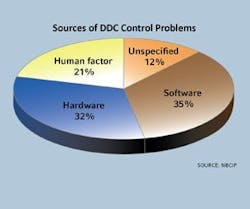Imagine if your car’s automatic transmission routinely upshifted only at the high RPMs of full-throttle acceleration, no matter how leisurely you were driving. You would be more than a little irate at the manufacturer who had not optimized controls for a range of common operating conditions.
We might harbor the same expectation for our buildings, but every building is unique, making building controls and systems far more difficult to optimize than those of a mass-produced car. Aside from the operational, occupancy, and use changes that a building typically undergoes in its lifetime, many buildings’ controls are not optimized from the outset.
The National Building Controls Information Program (NBCIP), an initiative sponsored by the EPA at the Iowa Energy Center to focus on the energy efficiency of direct digital controls (DDC), reported that ENERGY STAR® office buildings with DDC include some of the most energy-efficient buildings - as well as some of the most inefficient. Paradoxically, a complex energy management and control system (EMCS) does not ensure superior performance if a number of small problems create a synergy of inefficiency. “DDC can solve these problems as well as create them,” says Curtis Klaassen, manager at the Iowa Energy Center’s Energy Resource Station and a technical advisor to NBCIP.
A Case of RCx Success
NBCIP partnered with Portland Energy Conservation Inc. to document the RCx of the Hatfield Courthouse, a 592,000-square-foot federal building in Portland, OR. The single largest improvement made to the building involved the staging of the building’s three chillers over various loads. In particular, it was found that, because one chiller’s capacity was unequal to the others, the building required software programming to optimize performance.
The RCx remedied the chiller staging problem, as well as 10 other control problems that were identified at the courthouse. Seven of the problems involved software. NBCIP notes that such problems can go unnoticed when the control system is able to compensate enough to maintain occupant comfort.
Annual energy cost savings were estimated for four of the solutions; the result was a 10 percent decrease, totaling $56,000.
For inefficient buildings, retro-commissioning (RCx) can be one of the most effective ways to improve performance. California’s initiative to cut energy use by 20 percent in state-owned buildings by 2015 is depending on RCx to carry much of the weight. Of the 20 percent reduction, 8 percent is anticipated from RCx, and the remaining 12 percent from retrofitting.
A survey of 110 buildings by NBCIP found 380 control problems, which were then broken down into categories. The most frequent source of control problems was software at 35 percent, followed closely by hardware at 32 percent, and then human factor at 21 percent.
Is your building a candidate for RCx? The ENERGY STAR Building Manual notes that buildings with a high energy use index (BTUs/square foot, BTUs per patient, etc.), persistent control or equipment failures, and numerous occupant complaints are good indicators that RCx may be in order.
According to the ENERGY STAR manual, the average cost of RCx is 27 cents/square foot, and the resulting energy savings is 15 percent with a simple payback of 0.7 years; however, RCx can also reduce costs for maintenance and equipment replacement. A 2004 study by the Lawrence Berkeley National Laboratory found that non-energy savings from RCx ranged from 10 cents to 45 cents/square foot, while energy savings ranged from 11 cents to 72 cents/square foot.
Owners weighing the potential of RCx need to benchmark their buildings against others to estimate the possible savings. While an RCx provider can study all buildings in a portfolio to develop a plan, owners also have tools to start down the path on their own.
Portfolio Manager, ENERGY STAR’s benchmarking tool (www.energystar.gov), allows owners to enter their building data online in a private account. From there, owners can see how their buildings stack up with the national energy performance rating system, which is based on a DOE survey of building energy use that is conducted nationally every 4 years.
Chris Olson ([email protected]) is editor-in-chief at Buildings magazine.
